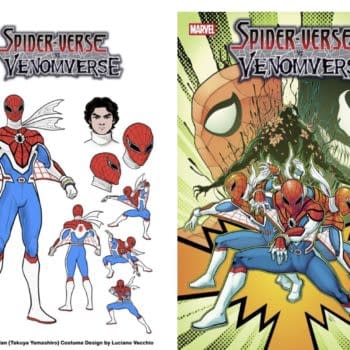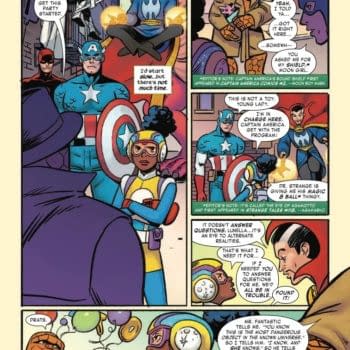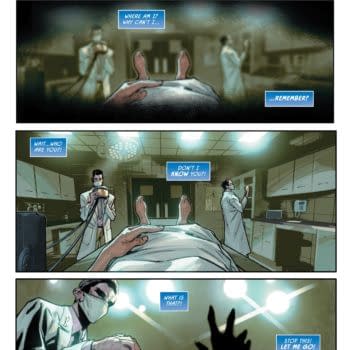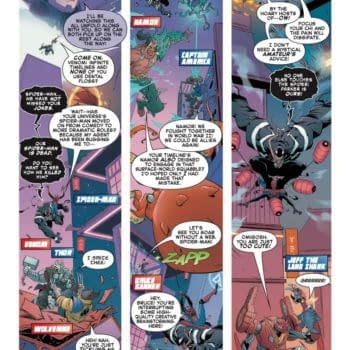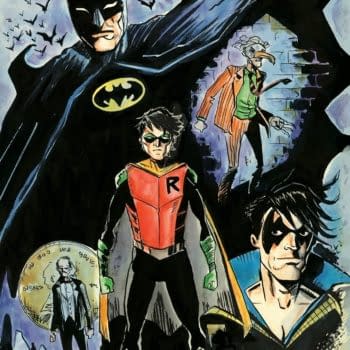Posted in: Comics, Recent Updates | Tagged: Alan Moore, avatar press, Comics, Crossed +100, entertainment, gabriel andrade, horror, science fiction
Advance Review: Alan Moore's Crossed +100 #1 Brings Us The Future Of Horror
Having interviewed Alan Moore about his six issue comic series Crossed +100 with Gabriel Andrade for Bleeding Cool and Bleeding Cool Magazine, I of all people should have had some idea what to expect from the first issue of the comic. We've heard about Moore's view on the science fiction aspects of the comic, about his heroine, archivist Future Taylor, and even his musings about why the Crossed universe piqued his imagination and what it's been like talking to friends Garth Ennis and Simon Spurrier about their take on Crossed, all through those interviews.*
And yet, I have to say, this knowledge did not prepare me for reading the finished Issue #1. I didn't expect the emotional impact the comic provoked, nor could I have completely visualized the ways in which Gabriel Andrade's art style so fully constructed the world of the story to increase that effect. I might have suspected, given Alan Moore's long history of making us care about characters and the impact of events on their lives that I wouldn't come through reading Crossed +100 unscathed, but sometimes having an intellectual knowledge of someone's work actually sets you up for a fall since you don't prepare yourself for the actual tools they are going to use to engage you as a reader when you pick up a story and experience it first hand.
Crossed +100 follows the lives of a group of survivors re-building a semblance of human society approximately 100 years after the Crossed outbreak which has rendered the majority of the human population destructive, bestial, and predatory in the most extreme sense. However, given the passage of time, the fallout from such an apocalypse is becoming clearer: there are some pros along with the cons. The environment, for instance, has bounced back from the destruction caused by overpopulation and industry, and it turns out that the Crossed, not at all geared toward their own long-term survival, have somewhat abated, leaving the potential for resurgent humanity to scavenge the remains of social structure and start anew.
Central character Future Taylor is a member of that forward-thinking generation and part of a settlement of "Chooga" (modern day Chatanooga, Tennessee), on the banks of the Mississippi river, and we follow her initial forays, with a search team, into a nearby city to reclaim library books and supplies in their modified rail engine transport. The team members with her are diverse in personalities and interests, and some of them are very young, in their teens. All of them share the common feature of never having actually seen an infected Crossed person first-hand, though they know the threat still looms of outbreak or invasion.
Does this sound like a horror comic? In some ways it might, especially in that horror stories often "set up" the status quo of their world about to be undermined or placed under threat. Gabriel Andrade's splendidly detailed artwork conveys a lush world populated by exuberant plant-life that offsets the desolation of the crumbling remains of 21st century life overtaken by nature. The wonder that the characters experience moving through these relics of the past captures the imagination of the reader in the same way that reading about explorers setting foot in an undisturbed Mayan ruin in the jungle might. We recognize that the books they hope to reclaim from a library are eminently practical, helping them rebuild basic knowledge that's been lost, but are struck by Future Taylor's inclination towards science fiction. It becomes a mystery of her character and personality: why would someone living in a devastated world want to read "wishful fiction" as she calls it? Are things so bad that even the bleak futures that science fiction often presents are a thing of beauty to her?
The alluring melody of this storyline, and the starkly beautiful character designs by Andrade lull us into contemplation of this world and these personalities at work. But if we listened a little more carefully, we might hear Alan Moore quietly sharpening his knives, the tools of narrative construction being carefully employed. Future Taylor is perhaps the biggest weapon in his arsenal of creating a horror comic, and Andrade is perfectly onboard with that strategy. Because if we care about her, then we inhabit her world of hope and risk.
The most distinctive way in which Moore and Andrade engage our emotions about Future are through her diary-narrative framing device. Her diary entries appear as a narrative thread as she records her reconnaissance mission, and Andrade presents them as hand-written torn notes guiding us through the mission. But once within the diary format, Moore capitalizes on use of language to create a voice for Future as well as for her society, and it's a language different from our own in the same way that Shakespeare's language is different than our own, removed from us in time, experience, and frame of reference. Common sayings have undergone shifts so that sound and oral tradition have been preserved, but spellings have been "lossed", for instance. It makes Future's voice sound unsophisticated, inviting, even sentimental. She's an ideal narrator because she is sentimental in contrast to the hard edge necessary to pursue her job and her own survival.
Some of the best science fiction horror that's been made in the past begins with fascination. Characters encounter the unknown, find it exciting or alluring, and then gradual come to understand the overwhelming nature of threat. We get that same alien feeling in Crossed +100 #1 as Future's team get their first glimpses of the realities of Crossed infection and don't quite know how to react to the danger involved. They are fascinated. They seem like innocents on the verge of devastating revelations, and that possibility is enough to tinge this opening movement to the series with horror even more than the piles of bones the characters are so used to encountering wherever they go in their desolate region.
If you read Crossed +100 #1, you'll be hooked, and you'll find that a little disturbing, because you'll suspect that the strange Eden of the first issue can't possibly last, but at the same time you'll want to follow these explorers into their own future to see what will become of them. Building that tension is much more the corner-stone of horror than overt, gory revelations, and that tension, to judge from this first issue, is going to permeate all the pages yet to come. Welcome to "future-horror", where hope becomes a particularly dangerous thing.
Crossed +100 #1 arrives in shops Wednesday, December 3rd, from Avatar Press.
*Interviews with Alan Moore on Crossed #100 appear in the "Taste Test" Special for the series released the last week of November in shops and also are forthcoming in Bleeding Cool Magazine #14.














